PUBLIC CROSSINGS AT GRADE
105-1. Wherever crossing protection is operated manually, it must be restored to normal after movement is completed and control boxes must be locked.
The location and operation of automatic protection is a part of the physical characteristics of the railroad and new installations or changes will be made effective by Bulletin Order or General Order.
At all crossings where signs are provided on other than main tracks to indicate "End of Circuit", trains and engines operating on such tracks must proceed past sign located adjacent to track and approximately fifty feet from crossing prepared to stop and not cross the highway until gates are in horizontal position. (Where flashing light signals are in service without gates, the flashing lights must be operating for at least 30 seconds.)
At all crossings where signs are provided on main tracks to indicate "End of Circuit" trains and engines stopping on main track must stop back of sign. When starting, if gates are raised (or flashing light not operating), must proceed past sign prepared to stop and not cross highway until gates are in horizontal position. (Where flashing light signals are in service without gates, flashing lights must be operating for at least 30 seconds.)
Where highway control boxes are provided, push buttons must be operated in accordance with instructions posted in the control box. "X" sign will be provided where close clearance prohibits the use of "End of Circuit" signs.
105-2. Trains or engines occupying approach circuits or crossings equipped with automatic protection must be operated as prescribed by Rule 105A.
105-3. Trains or engines stopping to perform switching or shifting of cars must stop within limit marked by yellow stripe on side of rail or sign (approximately 70 feet each side of crossing) but clear of highway, until protection is operating and highway is clear. If automatic protection fails to operate, the crossing must be protected in advance of each movement.
105-4. To prevent the obstruction of crossings, trains governed by signal indication not permitting a complete movement over public or railroad crossing at grade must stop clear of such crossing and contact operator or train dispatcher for instructions.
105-5. In the State of Michigan, no train or yard movement shall block any grade crossing for a period of longer than 5 minutes. When one movement has been on a grade crossing, no other train shall proceed over that crossing until all traffic has cleared, or 5 minutes has elapsed, whichever is shorter.
DEFINITIONS
Bulletin Order
Order issued by authority of and over the signature of the superintendent which contains items affecting the movement of trains.
NOTE:
Bulletin Orders issued and in effect will expire when S Bulletin issued and in effect. All bulletins older than last S Bulletin must be removed from Bulletin Boards.
Controlled Point
A place designated in the time table where signals are remotely controlled from the Control Station.
Division Notice
Notice issued by authority of and over the signature of the superintendent which contains instructions which do not affect the movement of trains.
General Order
Order issued by authority of and over the signature of the designated official, which contains changes in rules, time table or other instructions.
Running Track
A designated track on which movements may be made by signal indication or at Restricted Speed under authority of the employee designated in the time table.
Speeds
NORMAL SPEED - The maximum authorized speed
LIMITED SPEED - For passenger trains, not exceeding 45 mph. For freight
trains, not exceeding 40 mph.
MEDIUM SPEED - Not exceeding 30 mph.
SLOW SPEED - Not exceeding 15 mph.
RESTRICTED SPEED -Prepared to stop within one-half the range of vision, short of train, obstruction, or switch improperly lined, looking out for broken rail, but not exceeding 20 miles per hour outside interlocking limits, nor 15 miles per hour within interlocking limits. Speed applies to entire movement.
Summary Bulletin Order
A Bulletin Order issued periodically containing all information remaining in effect from previous Bulletin Orders.
Note:
Summary bulletin orders are identified by the letter S" included in the number.
GENERAL RULES
Rule Q
Employees subject to the Federal Hours of Service Act must familiarize themselves and comply with its requirements.
They must not exceed the maximum hours permitted by law unless authorized by the train dispatcher.
If an employee is called to report for duty before his legal rest period has expired, he must report that fact to the person ordering him to report.
Engine and train crews must notify the appropriate train dispatcher or other designated supervisor three hours before the expiration of their legal work period.
Rule 17
The headlight facing direction of movement on every train and engine must be displayed brightly by day and by night.
Headlight must be dimmed:
(1) While standing or passing through yards where other engines are working.
(2) Approaching stations where Form D is to be received.
(3) Approaching junctions, terminals and when standing or moving on main track at meeting points.
(4) In multiple track territory when standing or when approaching another train operating in the opposite direction except when approaching or passing over public crossings at grade.
Should the headlight fail enroute, the bell must be rung continuously and whistle sounded frequently. Speed must be reduced and engine must approach all public crossings at grade at Restricted Speed. Train dispatcher must be notified of the engine with defective headlight.
Rule 19
Except in yards, the rear of a train must be identified by a marker as prescribed below:
Passenger trains, light engines and engines operating at the rear of a train, must be equipped with an illuminated marking device or have the rear headlight on low beam at all times.
Trains other than passenger trains must be equipped with an illuminated marking device from one hour before sunset until one hour after sunrise, and when the visibility is so restricted that the end silhouette of a box car cannot be seen from one-half mile on tangent track. During other periods, a reflector, flag, or extinguished marking device may be used.
When an illuminated marking device will be required, it must be tested before a train leaves its initial terminal, and must be known to be working at all crew change locations.
Rule 19a
Should the marker fail while enroute, the train dispatcher must be notified as soon as practicable. The train may continue to the next terminal where repairs can be made.
Rule 26
A Blue Signal is a blue flag, blue tag or blue light by day or a blue light or blue tag by night.
(a) Blue Signals displayed signify that employees are on, under, or between rolling equipment. When displayed:
(1) The equipment must not be coupled to or moved.
(2) Other rolling equipment must not be placed on the same track so as to reduce or block the view of a Blue Signal.
(3) Rolling equipment must not pass a displayed Blue Signal.
(4) An employee, under the direction of the employee in charge of the workmen, may reposition an engine within an Engine Servicing Track Area, or rolling equipment within a Car Shop Repair Track Area, after employees on the affected track have been fully informed of the movement and Blue Signals have been removed from the equipment to be repositioned or coupled. The Blue Signals need not be removed from the switches or derails providing access to the track.
(b) Blue Signals must be displayed to protect a group of workmen prior to going on, under, or between rolling equipment, and may only be removed by the same group that displayed them, after all such workmen are clear.
(c) When emergency repair work is to be done on, under, or between rolling equipment, and a Blue Signal is not available, the engineer must be notified. The engineer-must have the brakes applied, reverser lever in neutral position or controller in off position, and generator field and/or control switch open, where equipped.
(d) Before employees work on, under, or between rolling equipment on a track other than a main track or controlled siding where entrance switches are remotely controlled, including hump yard classification tracks where employees couple air hoses or adjust coupling devices, the employee controlling the switches must be notified and protection provided.
After the employee controlling the remotely controlled switches has been notified that protection is required, each remotely controlled switch must be lined against movement to the track and an effective blocking device applied to the mechanism controlling movement of the switch, and a written record immediately made of the switches blocked on the prescribed form. The employee requesting protection may then be informed that protection has been provided.
The employee controlling the remotely controlled switches must not remove the blocking devices that were applied, until informed by the employee who requested the protection that the work has been completed. A written record must be made immediately of the removal of the blocking device protection on the prescribed form, which must be retained for a period of fifteen (15) davs.
Blue Signal protection must be provided for other than crew members when:
(1) Replacing, repositioning or repairing markers when the rear of the train is on any track.
(2) Inspecting markers by repositioning activation switch or covering photoelectric cell when the rear of the train is on other than a main track.
Rule 27
The absence of a fixed signal at a place where it is usually shown must be regarded as the most restrictive indication that can be given by that signal and immediately reported to the train dispatcher.
Except as indicated below, a signal imperfectly displayed must be regarded as displaying its most restrictive indication:
(a) When the indication of a position light signal or semaphore signal can be positively determined, it will govern.
(b) When the indication of a position light signal cannot be positively determined, but it can be determined that it is more favorable than Stop and Proceed, trains may proceed as though a Restricting Signal were displayed.
(c) When it can be determined that the indication of a color light signal is more favorable than Stop and Proceed, trains may proceed as though a Restricting signal were displayed.
(d) When sufficient lights in a color position light signal are displayed to determine the indication of the signal, it will govern.
Imperfectly displayed signals must be reported to the train dispatcher or operator as soon as practical, without delay to the train
Rule 29
When a signal, except a fixed signal, is given to stop a train, it must be acknowledged as prescribed by two short sounds of the engine whistle or horn.
Rule 30
When equipped, the engine bell must be sounded when an engine is about to move, when running through tunnels, while approaching and passing public crossings at grade, when passing a train standing on an adjacent track and in an emergency. Where a momentary stop and start, forward and backward movement is part of a switching operation and movement over public crossing at grade is not involved, the engine bell need not be sounded.
Rule 34
Employees qualified on the operating rules and located on the leading engine or car must observe and then communicate to each other in an audible and clear manner the name of each signal affecting the movement of their train as soon as the signal becomes clearly visible. After the name of a signal has been communicated, it must continue to be observed until passed and any change communicated in the required manner.
When a train is two (2) miles from a temporary restriction, qualified employees located on the leading engine or car must immediately communicate with the engineer and confirm the requirements of the restriction.
If train is not operated in accordance with the requirements of the signal indication or restriction, qualified employees located on the leading engine or car must communicate with the engineer at once, and, if necessary, stop the train.
Rule 60
Employees whose duties are affected by General Orders, Bulletin Orders and Division Notices must, when reporting for duty, familiarize themselves with such instructions pertaining to any portions of territory on which they are qualified or ordered to operate. They must have a copy of each General Order, Bulletin Order and Division Notice with them while on duty.
At locations specified in the time table, employees reporting for duty must, after examining the Bulletin Board, sign the Employees Register.
When an employee does not have a copy of the current information affecting the movement of his train, or reports for duty at a location where no Employees Register is located, he must contact the train dispatcher, who must inform him of all information affecting the movement of his train.
When a Bulletin Order or Division Notice is issued after the summary, a designated employee assigned to the train dispatchers office must insure that such information is properly posted at each Bulletin Board location. The train dispatcher must not consider such Bulletin Orders or Division Notices in effect at a Bulletin Board location until informed that the Bulletin Order or Division Notice is properly posted.
General Orders, Bulletin Orders and Division Notices will be numbered consecutively, prefixed by the number of the current time table, and contain a subheading indicating the territory in which they apply.
60-1
In the application of Rule 60 employees will not be required to have a copy of each Division Notice with them while on duty.
Rule 98
Trains must approach the end of two (2) or more tracks, junctions, railroad crossings at grade and movable bridges, prepared to stop, unless switches are properly lined, signals indicate proceed and track is clear.
When a signal at a movable bridge cannot be changed from stop after the bridge has been closed, or at any time a bridge unlock indication is received, a qualified employee must examine the bridge and determine that the rails are properly lined and the bridge is safe for movement, before verbal permission is given to pass the signal.
Rule 102.
When a train is moving and emergency application of the brakes occurs, adjacent tracks must be immediately protected by crew members initiating an emergency radio transmission in the manner described in the following example:
"Emergency, Emergency, Emergency, Train TV-24 engine 6605 is in emergency moving east on No. 2 track at MP 78. "
After the train has stopped, crew members must immediately provide flag protection in both directions on all main tracks and controlled sidings, including those of a foreign railroad, as prescribed by Rule 99a, until it is known that they are not obstructed, or until full protection has been provided by the train dispatcher or operator. The entire train must be examined before movement resumes to insure that no cars have derailed, no load has shifted, and no other condition exists which may endanger train movements. Results of such inspection must promptly be reported to the train dispatcher or operator.
All trains receiving information that a train is in emergency on an adjacent track must be governed as follows:
(1) A train, which is operating in the same direction as a train reported in emergency, must operate at Restricted Speed from one (1) mile before the reported location until reaching the head end of the train in emergency.
(2) A train, which is operating in the opposite direction as a train reported in emergency, must operate at Restricted Speed from the head end of the train in emergency to a point one (1) mile beyond the rear end of that train.
Some engines are equipped with a red flashing strobe light mounted on the lead end of the operating compartment. This light operates automatically when an emergency application of the brakes occurs.
Until it is known that there is no obstruction on adjacent tracks, the train dispatcher or operator must not permit trains to enter the block on adjacent tracks until notifying them of the situation, including direction, track, location and identity of the train in emergency.
Rule 105a.
Where apparatus is provided to automatically interrupt the operation of the automatic highway crossing protection, all movements approaching at Slow Speed, switching movements or movement resumed after having stopped, must be prepared to stop before passing over the crossing unless automatic protection is known to be operating. If the automatic highway crossing protection is not operating, the movement must not be made until protection is provided.
Rule 112
On a running track, unless otherwise specified, movements must operate at Restricted Speed after receiving either signal indication or permission of the employee governing movements on that track.
When movement has been completed, it must be reported clear except when clearing at an interlocking or block station.
Rule 113
Movements on tracks not governed by block system rules or interlocking rules must operate at Restricted Speed.
Rule 173
SIGNAL RULES
Rules governing movement of trains in either direction on the same track by block signals.
241.A train must not pass a Stop Signal without verbal permission of the train dispatcher, or operator when authorized by the train dispatcher. Permission must not be given or accepted until the train has stopped at the signal. A member of the crew must contact the train dispatcher or operator and be governed by his instructions.
(a) Permission must not be given until the train dispatcher or operator has:
(1) Determined that all affected appliances are properly positioned. When the position of a switch cannot be determined, the route must be inspected.
(2) Determined that no opposing or conflicting movements have been authorized.
(3) Applied blocking devices to the controls governing opposing movements, when the signal involved governs entrance to a track where Rule 261 is in effect.
(b) Permission to pass a Stop Signal must be given in the following manner:
No. 5316 engine 4129 pass Stop Signal on No. 2 track at Rare and proceed east to No. 1 track.
This permission must be repeated by the employee receiving and confirmed by the train dispatcher or operator.
(c) After receiving permission, train must operate at Restricted Speed until the entire train has:
(d) When a train is stopped at a home signal at an automatic interlocking and no immediate conflicting movement is evident, the movement will be governed by instructions posted at that location or by instructions in the time table.
If a Stop Signal is disregarded, the train dispatcher or operator must immediately attempt to stop that train and other trains involved, and notify the next open block or interlocking station in advance.
261. Signal indication will be authority for trains to operate in either direction on the same track.
A train must not clear the main track at a hand-operated switch not equipped with an electric lock except where Normal Speed on main track over such switch does -not exceed twenty (20) miles per hour.
271. The train dispatcher, or operator when authorized by the train dispatcher, may permit an opposing movement against the established direction of traffic or current of traffic to assist a disabled train. Before such authorization is given, the train dispatcher must issue Form D, line eight (8), to the disabled train. A member of the crew of the disabled train must provide flag protection against an opposing train moving at Restricted Speed as prescribed by Rule 99b. The train dispatcher must then issue Form D, line nine (9) to the assisting train. The assisting train must operate at Restricted Speed to the point named on Form D line nine (9).
The train dispatcher, or operator when authorized by the train dispatcher, may permit a following movement in Manual Block System territory to assist a disabled train. The train dispatcher must issue Form D line nine (9) to the assisting train. The assisting train must operate at Restricted Speed to the point named on Form D line nine (9), and must not proceed beyond that point without authority from the train dispatcher. The train dispatcher must not issue Form D line nine (9) until informing a member of the crew of the disabled train that a following movement will be authorized. A member of the crew of the disabled train must provide flag protection against a following train moving at Restricted Speed, as prescribed by Rule 99b.
Manual Block System and Automatic Block Signal System rules will not apply.
AUTOMATIC BLOCK
SIGNAL SYSTEM
504. A train may make a reverse move, at Restricted Speed, within the limits of the same block when preceded by a crew member, who must be prepared to stop an opposing movement operating at Restricted Speed.
The train dispatcher, or operator when authorized by the train dispatcher, may permit a train to make a reverse move, at Restricted Speed, within the limits of the same block, without a crew member preceding the movement. A crew member must be stationed on the leading end of the movement to observe conditions ahead and take action to properly control the movement of the train. Before permission is granted, the train dispatcher must determine that the track to be used is clear of opposing movements and that blocking devices have been applied to the affected switch and signal control mechanisms governing entrance to that track.
505. Where Rule 251 is in effect, a train having passed beyond the limits of a block must not re-enter that block without Form D line two (2) authority, as prescribed by Manual Block System rules.
506. Where Rule 261 is in effect, a train having passed beyond the limits of a block must not re-enter that block without verbal permission of the train dispatcher, or operator when authorized by the train dispatcher. Before permission is granted, the train dispatcher must determine that the track to be used is clear of opposing movements and that blocking devices have been applied to the affected controls governing entrance to that track.
When such permission is used, it must be given in the following manner:
No. 5306 engine 4129 reverse direction on No. 2 track at MP 5 and proceed west to MP 6.
Movement must operate at Restricted Speed until governed by a more favorable signal
509. A block station must not be opened or closed except as provided by time table, Bulletin Order, or form D. When a part time block station is open at an irregular hour, trains must be notified by Bulletin Order or Form D line thirteen (13). When a temporary block station is placed in service, trains must be notified by Bulletin Order or Form D line ten (10).
510. When a train has passed a signal and is delayed in the block, it must proceed at Restricted Speed. When the track is known to be clear to the next signal, and the next signal indicates proceed, train may be operated in accordance with the last signal indication received. In cab signal system territory, train may proceed in accordance with cab signal indication.
601. Interlocking signals govern the use of the routes of an interlocking. They must be cleared sufficiently in advance of approaching trains to avoid delay.
612. Engines or cars must not be left within the limits of interlocked railroad crossings at grade.
613. When a train has passed an interlocking signal and is delayed, it must proceed at Restricted Speed. When the track is known to be clear to the next signal, and the next signal indicates proceed, train may be operated in accordance with the last signal indication received. In cab signal system territory, train may proceed in accordance with cab signal indication.
When a signal indication permitting a train to proceed is changed to Stop Signal before it is reached, the stop must be made as soon as safe handling will permit. Such occurrences must be reported to the train dispatcher.
614. A train stopped by the train dispatcher or operator in making a movement through an interlocking must not move in either direction until it has received the proper signal or permission from the train dispatcher or operator.
615. Except at automatic interlockings, trains must not reverse direction within the limits of an interlocking without the proper interlocking signal or permission of the train dispatcher or operator.
616. When a train stops less than one (1) engine length beyond an interlocking signal, it must not proceed without permission of the train dispatcher or operator.
706. The following procedures will govern identification and content of messages when using radio:
To originate a call, identify the railroad by which employed, i.e., Amtrak, Bay Colony, Conrail, NJ Rail, NYS&W, P&W, or SEPTA.
Identify your base station, wayside station or yard station by name or other designation of station and location.
Identify your radio unit by schedule number if a scheduled train, by symbol and engine number if an extra train, or if a track car, TC followed by the number of the track car, or other appropriate unit identification.
Communications must be as brief as possible using these key words:
ROGER must be used to signify that message was received and understood. When required by Rule 710, "ROGER" also means that you have repeated instruction correctly.
OVER must be used at the close of each transmission to which a response is expected.
OUT must be used at the close of each transmission to which a response is not necessary.
EMERGENCY must be transmitted three times to obtain use of radio channels for initial report of conditions endangering train movements.
707. When positive identification is achieved in connection with switching, classification, and similar operations wholly within a yard, fixed and mobile units may use short identification after the initial transmission and acknowledgement. Short identification must include engine or unit number.
If an exchange of communications continues without substantial interruption, positive identification must be repeated every fifteen (15) minutes.
708. All employees shall give absolute priority to emergency communications and except in answering or aiding a station in distress, shall refrain from sending any communications until there is assurance that no interference will result to the station in distress.
709. When radio communication is used in lieu of hand signals in connection with the switching, backing or pushing of a train, engine, or car, the employee directing the movement shall give complete instructions or keep in continuous radio contact with the employees receiving the instructions. When means of communication is changed, no movement may be made until crew members have been notified. When backing or pushing a train, engine or cars, the distance of the movement must be specified, and the movement must stop in one-half the remaining distance unless additional instructions are received. Names of fixed signals affecting the movement of a train must be communicated to the engineer. If the instructions are not understood or continuous radio contact is not maintained, the movement must be stopped immediately and may not be resumed until the misunderstanding has been resolved, or communication has been restored.
710. Employees must insure being in communication with the proper persons and must not take action until certain that all conversation concerning them has been heard, understood and acknowledged.
All transmissions must be repeated by the employee receiving them except transmissions used in yard switching operations and those that do not contain any information, instruction or advice which could affect the safety of a railroad operation.
Any radio communication which is not fully understood or completed in accordance with the requirements of these rules, except emergency communications, shall not be acted upon and shall be treated as though not sent.
A train dispatcher or operator may accept information regarding the movement of a train from the conductor, engineer of another train or from a track car driver or from another qualified employee.
711. Train and engine crew members must not request and train dispatchers or operators must not advise the apect, name or indication of any fixed signal. Radio may be used by a train crew member to communicate a fixed signal to other members of the same crew. Radio communication may not be used to convey instructions which would have the effect of over-riding the indication of a fixed signal. However, when a train is approaching a location where conditions require that the crew know whether the train is to be held, crews may be instructed to stop at an appropriate location.
835. When work is to be performed on or near a track where block system or interlocking rules are in effect, and that work may interfere with the safe movement of trains, Form D line five (5) authority must be issued to the employee requesting to obstruct the track.
The approach to the restricted area must be indicated by an Approach Sign.
Within the working limits, the restricted limits must be indicated bv a Stop Sign and a Resume Speed Sign.
The train dispatcher must not issue Form D line five (5) authority until he has been notified by the empt-oyee in charge that the Approach Signs, Stop Signs and Resume Speed Signs have been properly placed. A speed limit sign may be substituted for the Stop Sign when the in-service track is not obstructed. Unless otherwise instructed by the employee in charge, trains must not exceed thirty (30) miles per hour through the restricted area.
Trains approaching the obstruction must be notified by Bulletin Order or Form D line five (5).
A train must not pass the Stop Sign until permission has been received from the employee in charge. Unless otherwise instructed by the employee in charge, trains must not exceed thirty (30) miles per hour through the restricted area.
The following abbreviations are authorized for use in
writing authorizations in Form D's and other forms:
ABS Automatic Block Signal System
APB Absolute Permissive Block
BO Bulletin Order
C&E Conductor and Engineer
Cndr Conductor
CP Controlled Point
Cs Controlled Siding
CSS Cab Signal System
Dspr Train Dispatcher
Eng Engine or Control Car
Engr Engineer
Frm Foreman
Frt Freight
Int Interlocking
Jct Junction
MBS Manual Block System
MP Mile Post
MPH Miles Per Hour
MW Maintenance of Way
No. Number
Opr Operator
Psgr Passenger
St Street
TBS Temporary Block Station
TC Track Car
Trk Track
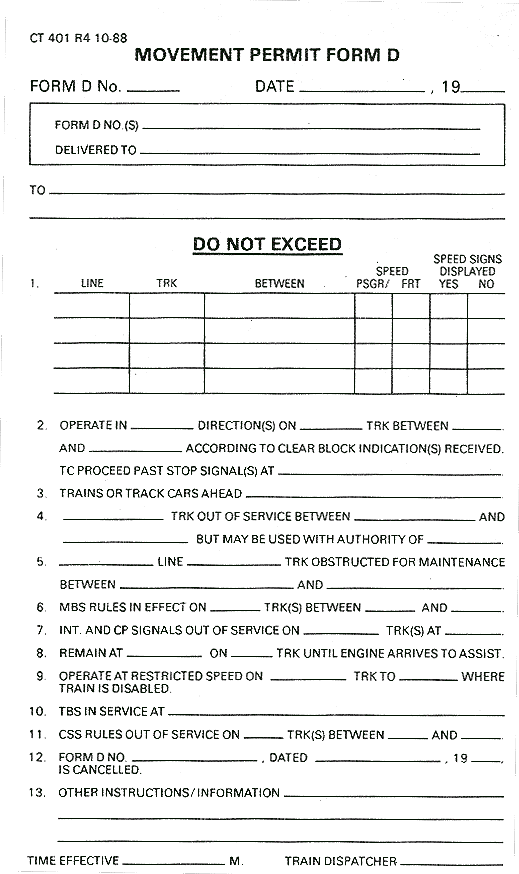
(1) Passed a more favorable fixed signal.
(2) Passed a location where a more favorable cab signal was received.
(3) Entered manual block system territory.
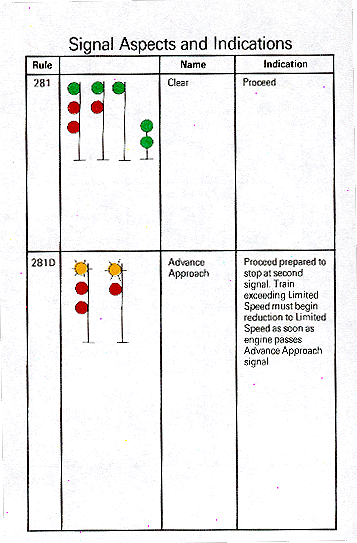
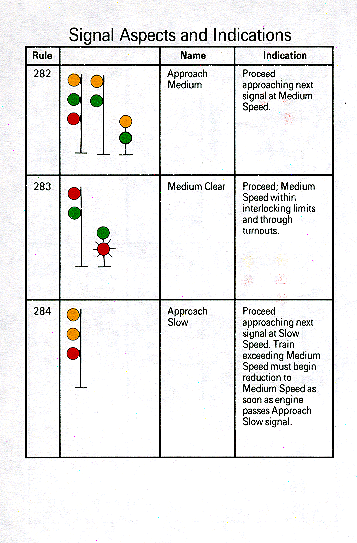
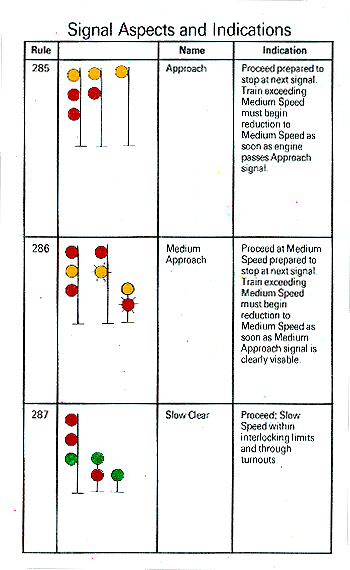
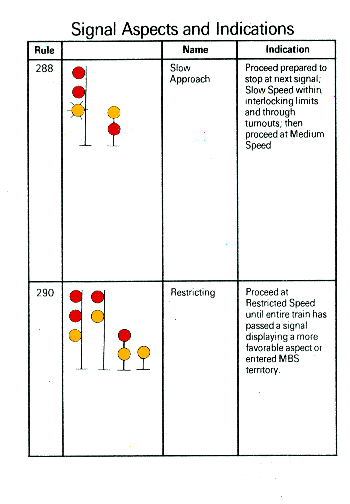
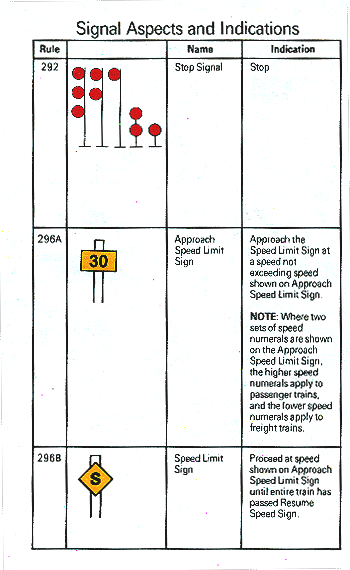
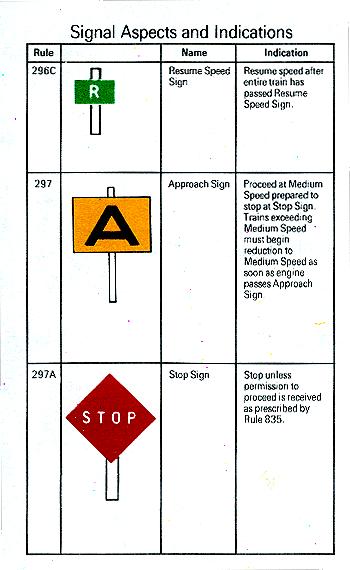
INTERLOCKING RULES
RADIO AND TELEPHONE RULES
PROTECTION BY STOP SIGNS WHEN A TRACK IS OBSTRUCTED FOR MAINTENANCE